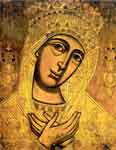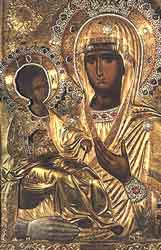.

13th c. Great Panagia from Yaroslavl.
Panagia (Greek: Παναγία, All-holy), also Panayia or Panaghia, is one of the titles of Mary, the mother of Jesus, used especially in Orthodox Christianity.
If Mary is honored as Theotokos, so too, she is honored because she is Panagia All-Holy. She is the supreme example of the cooperation between God and Man; for God, Who always respects human freedom, did not become incarnate without her free consent which, as Holy Scripture tells us, was freely given: Behold, I am the handmaid of the Lord; let it be to me according to your word (Luke 1:38). Thus Mary is seen by the Church as the New Eve (as Christ is the New Adam) whose perfect obedience contrasted the disobedience of the First Mother, Eve, in Paradise. As St. Irenaeus says, the knot of Eve's disobedience was loosed through the obedience of Mary; for what Eve, a virgin, bound by her unbelief, that Mary, a virgin, unloosed by her faith [Against the Heresies, III, xxii, 4]. (A Monk of St. Tikhon's Monastery (Comp. & Ed.) (1986). These Truths We Hold - The Holy Orthodox Church: Her Life and Teachings. South Canaan: St. Tikhon's Seminary Press. ISBN 1878997327)
There are many Orthodox churches dedicated to Mary that are called Panagia; for example, this one.
Iconography
Panagia is also the term for a particular type of icon of the Theotokos, facing the viewer directly, usually depicted full length with her hands in the orans position, and with the image of Christ as a child in front of her chest [1]. This type of icon is also sometimes called Platytera (Greek: Πλατυτερα); poetically, by containing the Creator of the Universe in her womb, Mary has become Platytera ton ouranon (Πλατυτερα των ουρανων): "More spacious than the heavens". This type is also sometimes called the Virgin of the Sign or Our Lady of the Sign, a reference to Isaiah 7:14 ("Therefore the Lord himself shall give you a sign; Behold, a virgin shall conceive, and bear a son, and shall call his name Immanuel"). Such an image is often placed in the apse of the sanctuary of an Orthodox church above the altar [2].
As with most Orthodox icons of Mary, the letters ΜΡ ΘΥ (short for ΜΗΤΗΡ ΘΕΟΥ, Mother of God) are usually placed on the left and right parts of the icon.
Vestment
By extension of this last sense, a panagia can also be an engolpion with an icon of the Theotokos, worn by an Orthodox bishop. They can be very simple [3] or extremely elaborate [4], depending on the personal taste of the particular bishop.
When an Orthodox bishop is vested for the Divine Liturgy or another service, he wears a panagia and a pectoral cross over his other vestments [5]. The primate of an autocephalous church, when fully vested, wears a panagia, a pectoral cross, and an engolpion of Jesus [6]. Bishops of all ranks when not vested will usually wear the panagia alone over their riassa [7]; this is often the detail that, to the casual observer, distinguishes a bishop from a priest or a monk
Blessed bread
Panagia may also refer to prosphora which is solemnly blessed (αρτος της παναγιας) in honor of the Theotokos during the Divine Liturgy, a practice today usually only performed in Greek monasteries. This bread is blessed over the holy table, before the blessing of the antidoron, with the phrase "Great is the name of the Holy Trinity." After the liturgy, the bread is distributed to those assembled; see prosphora for details.

Icon Panagia Skopiotissa, possibly from the 13th century, possibly from the island of Zakynthos
Place name
There are several islands and villages in Greece named Panagia. Many of these take their name from the churches and monasteries there, which are dedicated to Mary. For example, see Panagia Village on Thassos and the nearby Panagia Island. See also Panagia, Cyprus.
The Greek given names Panagiotis (male) and Panagiota (female) also derive from this title of the Virgin Mary.

Panagia Icon with the three hands. The monastery of Chilandar contains the icon of Panagia tricherousa (Παναγία Τριχερούσα), or "Panagia with the three hands"
Reference
- The Blackwell Dictionary of Eastern Christianity, p. 368 (ISBN 0631232036)
![]()
Panagia Thrinodousa, Ioasaf Athonites
| Ancient Greece
Science, Technology , Medicine , Warfare, , Biographies , Life , Cities/Places/Maps , Arts , Literature , Philosophy ,Olympics, Mythology , History , Images Medieval Greece / Byzantine Empire Science, Technology, Arts, , Warfare , Literature, Biographies, Icons, History Modern Greece Cities, Islands, Regions, Fauna/Flora ,Biographies , History , Warfare, Science/Technology, Literature, Music , Arts , Film/Actors , Sport , Fashion --- |
From Wikipedia, All text is available under the terms of the GNU Free Documentation License

